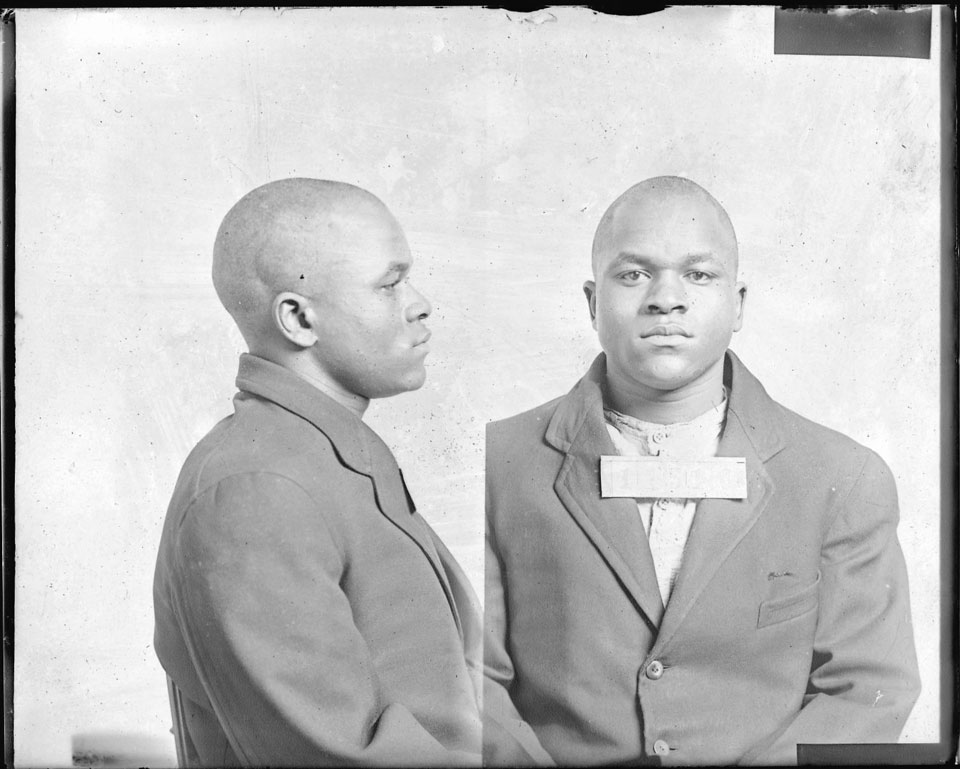This is the latest entry in a series of posts highlighting inmate photographs in the records of the Virginia Penitentiary. Ed Carr, the subject of this week’s post, escaped from a convict road camp in 1913. Jealousy led to his recapture in 1932.
Ed Carr was arrested in April 1913 and charged with grand larceny of a diamond ring. Hoping to get a shorter sentence, Carr lied about his age. “At this time,” Carr wrote Governor John Pollard in 1932, “I was 15 years old. When I was arrested on the charge the people who were in jail with me, told me that if I told my correct age they would send me to a reform school until I was 20 or 21 years old, but that if I ran my age up, and in case of conviction, I would get a year in the Penitentiary. I listened to this, and gave my age as 25 when I came up for trial.” It did not work. Carr was convicted on 3 May 1913 in the Corporation Court of Norfolk City and sentenced to 10 years in the Virginia Penitentiary. Carr was assigned to State Convict Road Force Camp No. 5 in Russell County. He didn’t stay long. Carr escaped on 7 August 1913 having served less than 90 days of his sentence. Carr later claimed to Governor Pollard that “the continued insistence of the other prisoners that they would not serve an unjust sentence, and being only 15 years old, I took the first opportunity to escape.”
Carr provided different accounts of his life during the 19 years on the run. He wrote Governor Pollard in 1932 that after his escape he went to work in Springfield, Ohio, and later in the mines in West Virginia. He claimed he married shortly after his escape, that his wife was now dead, and that he had two small children. Armistead Sapp, a Greensboro, North Carolina, attorney representing Carr wrote Pollard in 1933 that during the 1920s Carr claimed he worked at a grist mill in Mt. Gilead, Ohio, and in New York cleaning Pullman cars. Carr was adamant that “I have never been into any kind of trouble during this [sic] 20 years of my freedom, and have had no trouble at all.” That was not true. Carr, using the names C.E. Smith and Ed Smith, served two sentences (1916-1917 and 1923-1926) in the Kentucky State Reformatory for grand larceny.
Acting on a tip that he was an escaped convict, the police in Portsmouth, Ohio, arrested Everett Carter, alias Willie Stiles, alias Ed Carr, on 13 August 1932. Jealousy was Carr’s undoing. According to the 19 August 1932 Portsmouth Times (Ohio), Carr was “keeping with a woman in the North End and the man, whom the woman jilted for Carr, gave police the information which led to Carr’s arrest.” Carr initially denied he was an escaped prisoner. His Virginia Penitentiary mug shot confirmed his identity and he was extradited to Virginia. Penitentiary Superintendent Rice M. Youell sent Carr to State Convict Road Camp No. 4. In a 16 September 1932 letter to Camp Sgt. R.J. Garnett, Youell warned him to keep an eye on Carr because “he has a good deal of rabbit blood in him. Carr’s application for a pardon was denied by Governor Pollard on 5 May 1933. Carr was discharged on 2 March 1939.
-Roger Christman, Senior State Records Archivist

























What happened to Mug Shot Monday??
Due to other projects, Mug Shot Monday has been on an unofficial hiatus. I hope to have some new posts ready in the near future. Thanks for reading!